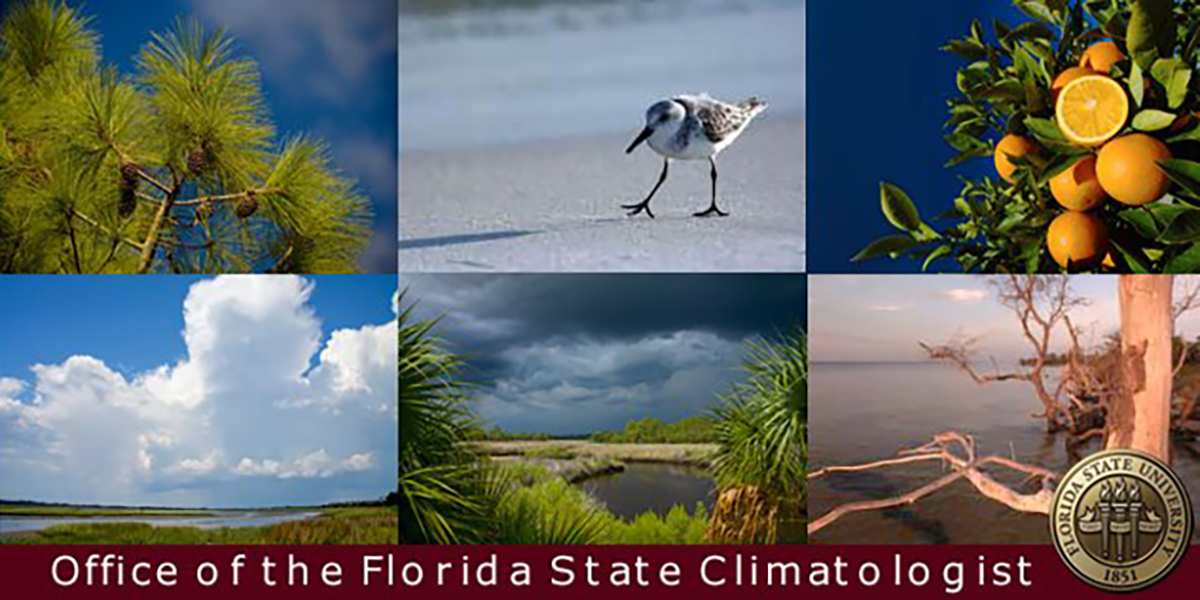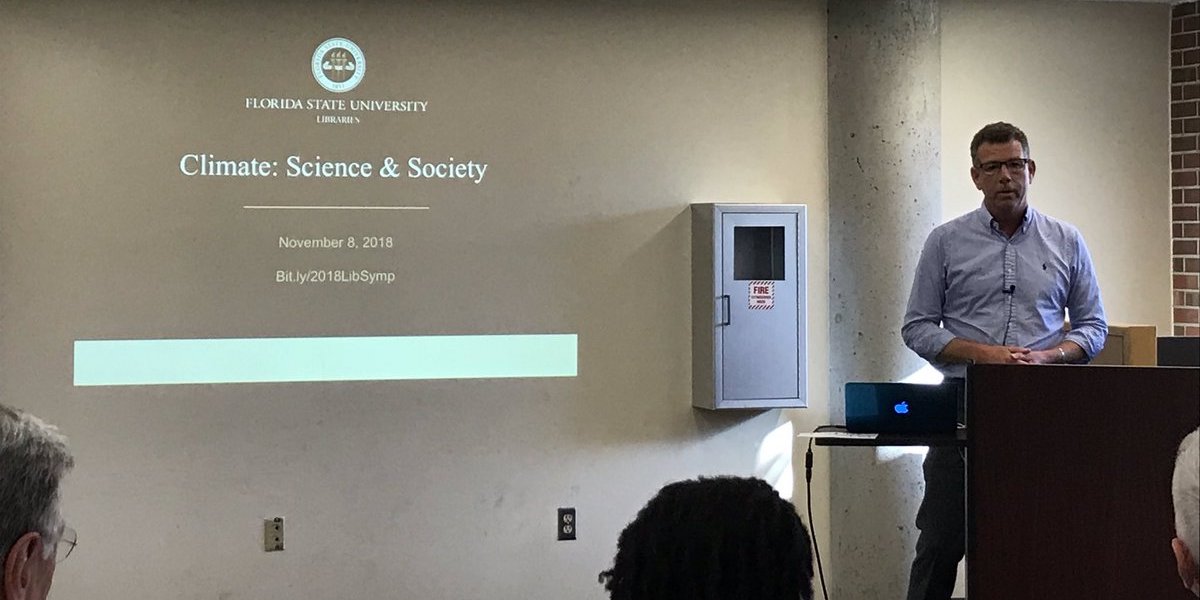The Florida Climate Center serves as the primary resource for climate data, information, and services in the state of Florida.
What's new in our world?
The Florida Climate Center achieves its mission by providing climate monitoring, research, and expertise to be applied by the people, institutions, and businesses of Florida and the surrounding region.
We provide direct service by fulfilling requests for climate and weather data and information in a variety of formats.
We perform research that advances the understanding of the climate variability and changes of Florida and the surrounding region.
We provide outreach in presentations and at events aimed at a variety of groups, interests, and ages.
Prepared by Florida Climate Center
The Florida State University
Tallahassee, FL
October Key Points:
- Average temperatures during October were above normal for much of the state.
- The Florida Panhandle experienced above normal rainfall totals, while the rest of the state experienced below normal rainfall for the month.
- La Niña conditions have returned with an 87% chance of continuing through February.
- Abnormally dry conditions emerged over eastern-northeastern parts of Florida late in the month.
- Red tide (Karenia Brevis) affected the estuaries of the Apalachicola River and the Florida Panhandle.
Average temperatures in October were above normal across the state. Average temperature departures ranged from +0.6 ̊F in Key West and Jacksonville to +3.3 ̊F in Orlando for the month (see Table 1 and Appendix 1 for select cities). Tampa, Fort Myers, and Jacksonville Beach had their third warmest Octobers on record, while Orlando had its fourth warmest October on record. Several daily high maximum temperature records were set, and many daily high minimum temperature records were set during the month (see Appendix 2).
Table 1. October average temperatures and departures from normal ( ̊F) for selected cities.
| Station | Mean Temperature | Departure from Normal |
| Pensacola | 73.4 | +2.1 |
| Tallahassee | 71.5 | +1.2 |
| Jacksonville | 71.8 | +0.6 |
| Orlando | 78.8 | +3.3 |
| Tampa | 80.4 | +3.0 |
| Miami | 81.2 | +1.1 |
| Key West | 81.9 | +0.6 |
Rainfall totals in October were above normal in the Panhandle and northern regions but below normal for much of the rest of the state (Figure 1). Monthly departures from normal ranged from +4.66 inches in Pensacola to -4.71 inches in Key West (Table 2 and Appendix 1). Monthly departures from normal ranged from +8.58 inches in Pensacola to -2.74 inches in Miami (Table 2 and Appendix 1). The western Panhandle region continues to be wetter than normal, with a surplus in annual rainfall at Pensacola of just over 28 inches above normal for the year to date. Pensacola had its fifth wettest October on record (seventh for the area overall), and Lakeland also had its fifth wettest October on record.
Table 2. October precipitation totals and departures from normal (inches) for selected cities.
| Station | Total Rainfall | Departure from Normal |
| Pensacola | 13.28 | +8.58 |
| Tallahassee | 5.29 | +2.05 |
| Jacksonville | 4.15 | +0.12 |
| Orlando | 3.21 | -0.25 |
| Tampa | 1.35 | -0.99 |
| Miami | 4.91 | -2.74 |
| Key West | 3.27 | -2.40 |
Figure 1. A graphical depiction of the monthly rainfall departure from normal (inches) for October (courtesy of NOAA, NWS).
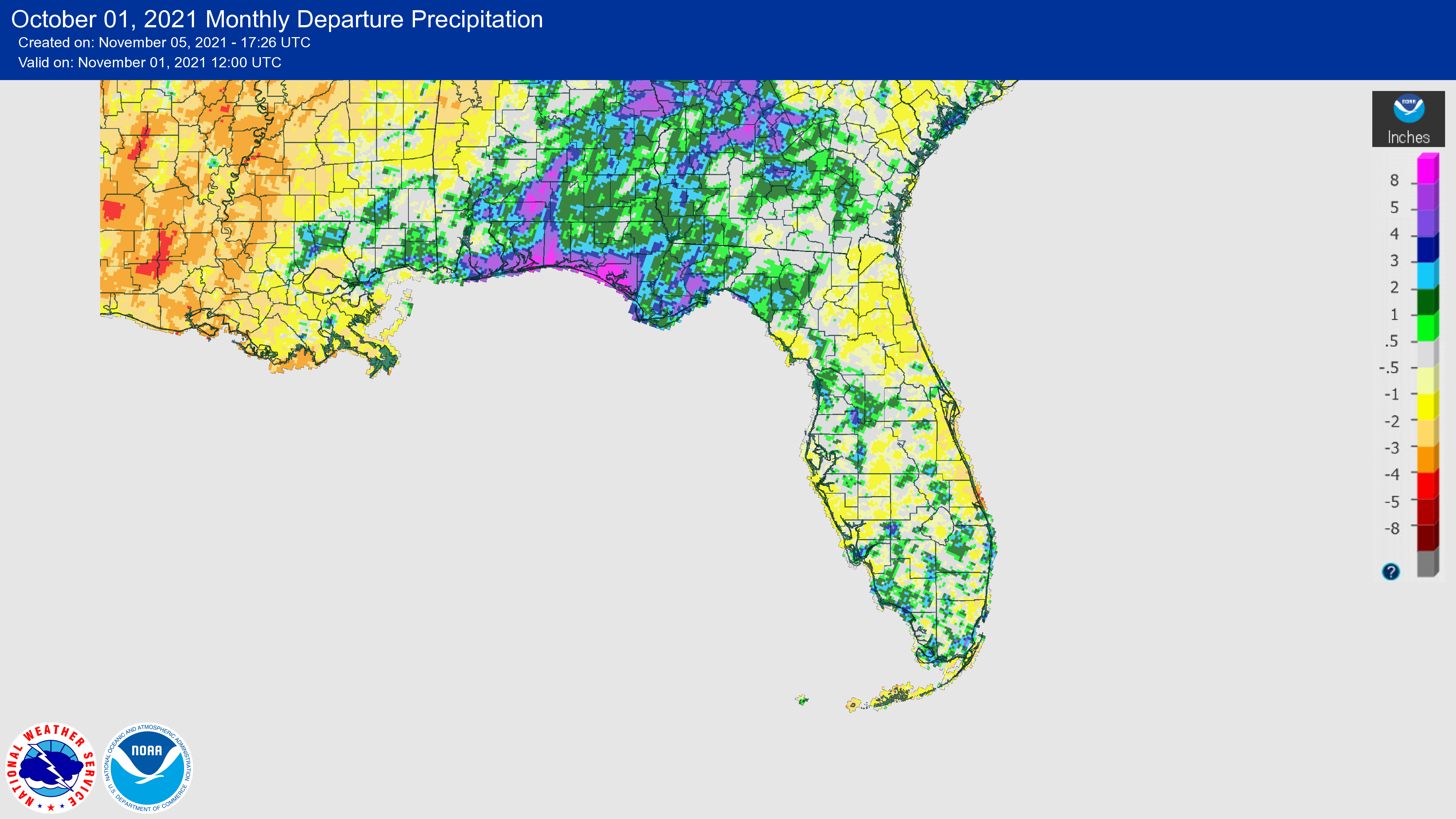
La Niña Advisory.
La Niña conditions, the cool phase of the ENSO climate pattern, returned to the tropical Pacific Ocean in October. Below-average subsurface temperatures (averaged from 180-100°W) strengthened significantly over the past month, as negative anomalies were observed at depth across most of the central and eastern Pacific Ocean. There is an 87% chance of La Niña conditions continuing in the Northern Hemisphere winter from December 2021 – February 2022. At its peak, a moderate-strength La Niña is favored. ENSO-neutral conditions are predicted to return during March-May 2022.
Hazardous Weather Events in October.
According to the Local Storm Reports issued by the local National Weather Service offices serving Florida, there were 201 individual local reports of hazardous weather events recorded across the state during the month of October (see Table 4 for a breakdown by event type). Early in the month, on October 7th, coastal areas of Bay County received daily rainfall amounts of between 3.55 and 8.67 inches of rainfall with reports of heavy rain and flash flooding. Despite reports of flooding, strong wind gusts, and two tornadoes throughout the month, no injuries or fatalities were reported.
Table 4. Breakdown of storm reports submitted in Florida during the month of October (compiled from Iowa State University/Iowa Environmental Mesonet).
| Report Type | Number of Reports |
| Flood | 7 |
| Flash Flood | 37 |
| Hail | 0 |
| Heavy Rain | 18 |
| Marine Thunderstorm Wind | 44 |
| Non-Thunderstorm Wind Gust | 36 |
| Non-Thunderstorm Wind Damage | 1 |
| Tornado/Waterspout/Funnel Cloud | 2/14/4 |
| Thunderstorm Wind Damage | 6 |
| Thunderstorm Wind Gust | 29 |
| Lightning | 1 |
| High Sustained Winds | 2 |
Drought-Related Impacts.
Much of the month of October remained drought free across the state; however, abnormally dry conditions emerged toward the end of the month across eastern and northern parts of the state. As of October 26, 15.5% of the state was experiencing abnormally dry conditions (D0), according to the U.S. Drought Monitor.
As of October 31, the Lake Okeechobee water level was at 15.87 ft. above sea level (Feet-NGVD29), which is above the average for this time of the year. The water level remained above average throughout the month. At the first of the month, the water level was 15.57 ft. above sea level.
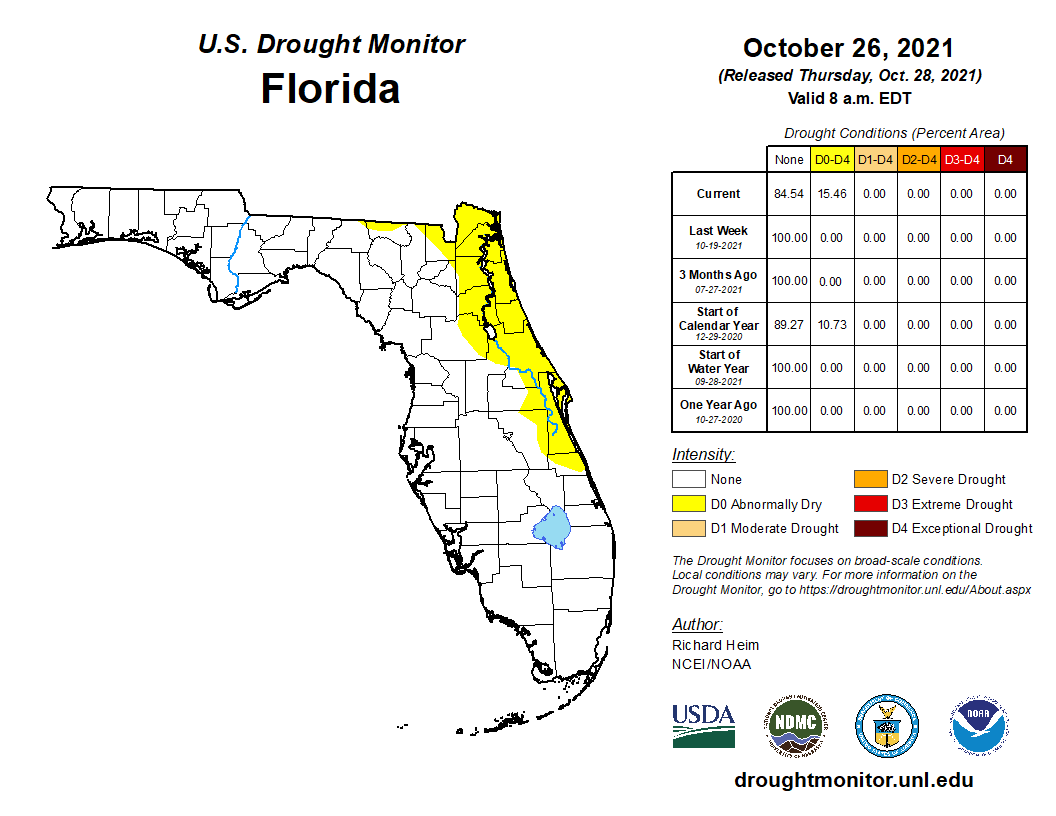
Agriculture-Related Impacts.
During mid-October, topsoil moisture levels were adequate for 65% of the state, short in 11%, and very shot in 1% of the state; 23% of the state was in surplus. By the end of October, topsoil moisture levels were adequate in 65% of the state, short in 18%, and very short in 1%; 16% of the state was in surplus. Much of the state had either fair (27%), good (47%) or excellent (23%) pasture and range conditions by the end of the month. For more information, consult the weekly Crop Progress and Conditions report published by the USDA's National Agricultural Statistics Service.
Appendix 1
Additional October departures from normal data for select Florida locations (Source: NWS).
| Station | Average Temperature (˚F) | Departure from Normal (˚F) | Total Rainfall (in.) | Departure from Normal (in.) |
| Gainesville | 72.6 | +1.2 | 1.84 | -0.84 |
| Sarasota | 79.0 | +1.7 | 1.03 | -1.73 |
| Melbourne | 77.6 | +0.1 | 2.72 | -2.14 |
| Fort Myers | 81.2 | +3.2 | 3.19 | +0.11 |
| West Palm Beach | 80.3 | +1.6 | 9.02 | +3.12 |
Appendix 2
Select daily record high minimum temperatures tied or broken during October (compiled from NOAA).
| Location | Date | Record (˚F) | Broken/Tied | Last |
| Vero Beach | 1 | 80 | Broken | 79 in 2019 |
| Fort Lauderdale Beach | 3 | 80 | Tied | 80 in 2019 |
| Key West | 3 | 82 | Tied | 82 in 1991 |
| Jacksonville Beach | 6 | 80 | Broken | 78 in 2019 |
| Tampa | 6 | 79 | Tied | 79 in 2009 |
| Key West | 6 | 83 | Broken | 82 in 2019 |
| Key West | 7 | 85 | Broken | 83 in 2009 |
| Bradenton | 8 | 77 | Tied | 77 in 2005 |
| Key West | 8 | 84 | Broken | 82 in 2017 |
| Fort Myers | 15 | 75 | Tied | 75 in 2018 |
| Jacksonville Beach | 16 | 84 | Broken | 78 in 2019 |
| Vero Beach | 21 | 77 | Tied | 77 in 2017 |
| Bradenton | 24 | 74 | Broken | 72 in 2020 |
| Jacksonville Beach | 24 | 76 | Broken | 74 in 1984 |
| Orlando | 24 | 73 | Broken | 72 in 2019 |
| Fort Myers | 24 | 76 | Broken | 75 in 2019 |
| Orlando | 24 | 72 | Broken | 71 in 2020 |
| Bradenton | 25 | 75 | Tied | 75 in 2019 |
| Punta Gorda | 25 | 75 | Tied | 75 in 2001 |
| Miles City | 25 | 75 | Broken | 74 in 2020 |
| Gainesville | 25 | 72 | Broken | 69 in 2019 |
| Fort Myers | 25 | 77 | Broken | 76 in 2019 |
| Orlando | 25 | 75 | Broken | 74 in 2020 |
| Jacksonville | 25 | 73 | Broken | 72 in 2020 |
| Punta Gorda | 26 | 75 | Broken | 74 in 2020 |
| Venice | 26 | 77 | Broken | 74 in 2019 |
| Ochopee | 26 | 77 | Broken | 75 in 2019 |
| Key West | 26 | 80 | Broken | 79 in 2020 |
| Ochopee | 29 | 76 | Broken | 75 in 2019 |
| Fort Myers | 29 | 76 | Broken | 75 in 2019 |
Prepared by Florida Climate Center
The Florida State University
Tallahassee, FL
December Key Points:
- December was much warmer, with average temperatures well above normal across the state.
- Rainfall totals for the month were below normal in most places.
- A La Niña advisory remains in effect and is expected to continue through the winter (95% chance).
- Abnormally dry conditions (D0) emerged across much of the Panhandle by the end of the month.
Average temperatures in December were well above normal across Florida. Following a colder than normal month of November, December was much warmer with average temperature departures ranging from +9.1 ̊F in Pensacola to +2.5 ̊F in Key West for the month (see Table 1 and Appendix 1 for select cities). Pensacola had its top warmest December on record, while the Gainesville, Orlando, and Tampa areas saw their second warmest Decembers on record. Several daily high maximum and high minimum temperature records were set throughout the month (see appendix 2).
Table 1. December average temperatures and departures from normal ( ̊F) for selected cities.
| Station | Mean Temperature | Departure from Normal |
| Pensacola | 64.6 | +9.1 |
| Tallahassee | 62.3 | +7.9 |
| Jacksonville | 63.4 | +6.7 |
| Orlando | 69.9 | +6.6 |
| Tampa | 71.5 | +6.6 |
| Miami | 74.5 | +3.3 |
| Key West | 75.5 | +2.5 |
Rainfall totals in December were below normal throughout much of the state (Figure 1). Drier conditions closed out the year, with monthly departures from normal ranging from -0.40 inches in Orlando to -3.82 inches in Pensacola (Table 2 and Appendix 1). Rainfall totals in inland areas of the state, including Gainesville and Orlando, were near normal for the month.
Table 2. December precipitation totals and departures from normal (inches) for selected cities.
| Station | Total Rainfall | Departure from Normal |
| Pensacola | 1.58 | -3.82 |
| Tallahassee | 1.39 | -2.85 |
| Jacksonville | 1.61 | -1.17 |
| Orlando | 2.08 | -0.40 |
| Tampa | 0.59 | -1.97 |
| Miami | 1.19 | -1.25 |
| Key West | 1.01 | -1.15 |
Figure 1. A graphical depiction of the monthly rainfall departure from normal (inches) for December (courtesy of NOAA, NWS).
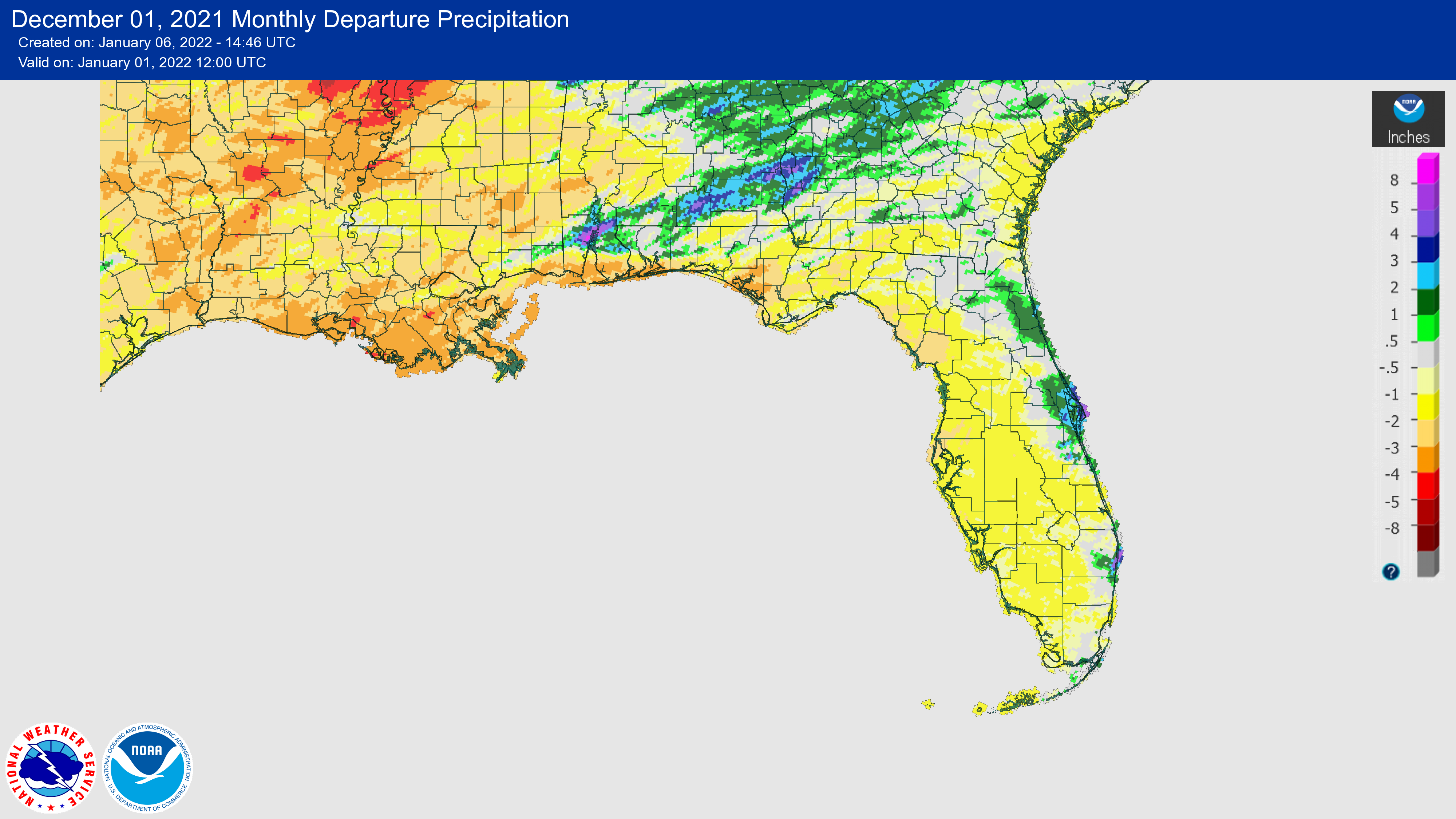
La Niña Advisory.
La Niña conditions, the cool phase of the ENSO climate pattern, continued in the tropical Pacific Ocean in December. Below-average subsurface temperatures (averaged from 180-100°W) strengthened significantly over the past month, and the sea surface temperature in the Niño-3.4 region of the tropical Pacific was about 0.9 °C cooler than the long-term (1991–2020) average. There is a 95% chance of La Niña conditions continuing through the Northern Hemisphere winter, and it is anticipated to transition to ENSO-neutral during the spring 2022 (~60% during April-June).
Hazardous Weather Events in December.
According to the Local Storm Reports issued by the local National Weather Service offices serving Florida, there were 46 individual local reports of hazardous weather events recorded across the state during the month of December (see Table 4 for a breakdown by event type). Tornadoes caused damage to homes in Starke and Freeport on the 8th, and another tornado report in Lee County on the 21st that led to one injury. On the 6th, dense fog in Quincy led to a collision that resulted in two fatalities; visibility was under one-quarter mile.
Table 4. Breakdown of storm reports submitted in Florida during the month of December (compiled from Iowa State University/Iowa Environmental Mesonet).
| Report Type | Number of Reports |
| Flash Flood | 0 |
| Flood | 0 |
| Heavy Rain | 0 |
| Dense Fog | 1 |
| Marine Thunderstorm Wind | 9 |
| Non-Thunderstorm Wind Gust | 15 |
| Non-Thunderstorm Wind Damage | 3 |
| Tornado/Waterspout/Funnel Cloud | 3/1/0 |
| Thunderstorm Wind Damage | 4 |
| Thunderstorm Wind Gust | 9 |
| Lightning | 0 |
| Wildfire | 1 |
Drought-Related Impacts.
Through the month of December, abnormally dry conditions (D0) were present in parts of the Panhandle and had expanded to the entire Panhandle by end of the month. By December 28, about 22.6% of the state was experiencing abnormally dry conditions, according to the U.S. Drought Monitor.
As of December 31, the Lake Okeechobee water level was 15.52 ft. above sea level (Feet-NGVD29), which is above the average for this time of the year. The water level remained above average throughout the month. At the first of the month, the water level was around 15.8 ft. above sea level.
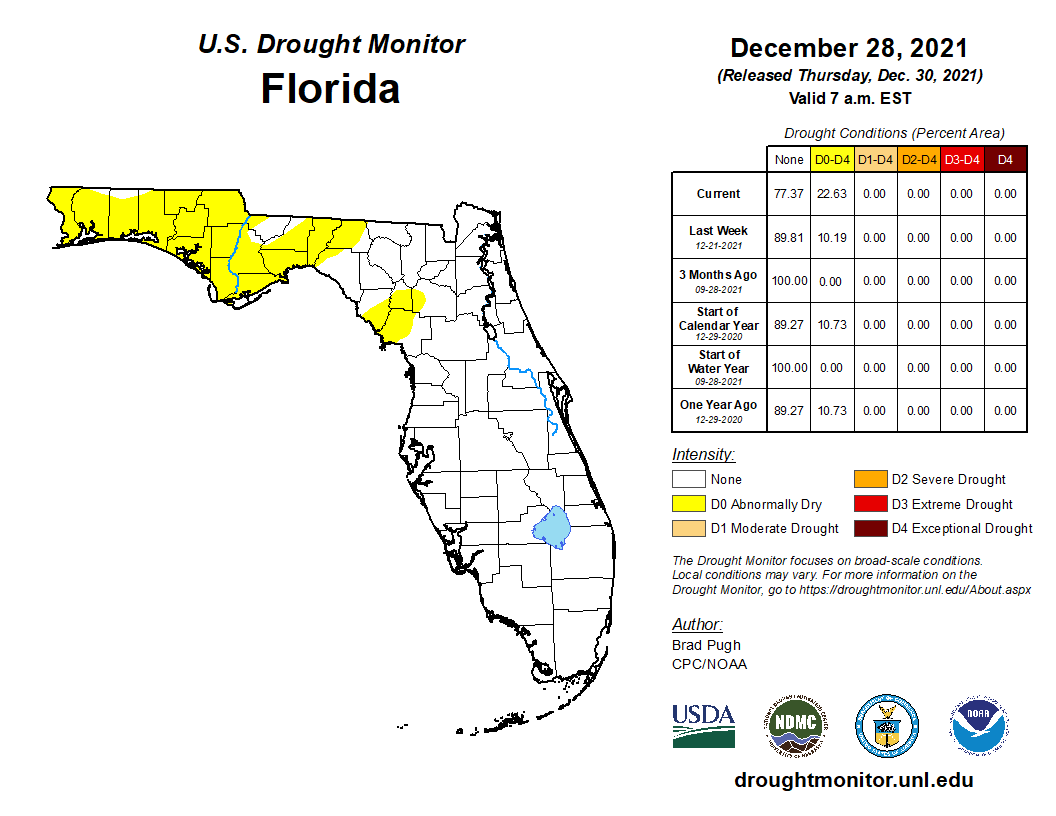
Agriculture-Related Impacts.
During the month of December, Florida pasture conditions remained mostly fair to good due to unseasonably warm weather. Cattle conditions also remained mostly good during the month, and sugarcane planting and harvest progressed well. Toward the end of the month, disease in the southern region of the state continued due to heavy fog. Many citrus fruits were harvested, and several vegetable crops came to market. For more information, consult the Crop Progress - State Stories reports, which are produced monthly December through March.
Appendix 1
Additional December departures from normal data for select Florida locations (Source: NWS).
| Station | Average Temperature (˚F) | Departure from Normal (˚F) | Total Rainfall (in.) | Departure from Normal (in.) |
| Gainesville | 64.5 | +7.2 | 2.88 | 0.00 |
| Sarasota | 69.3 | +4.1 | 0.92 | -1.41 |
| Melbourne | 69.0 | +2.8 | 3.39 | +1.03 |
| Fort Myers | 72.6 | +5.3 | 0.54 | -1.36 |
| West Palm Beach | 72.3 | +3.3 | 2.16 | -1.32 |
Appendix 2
Select daily record high maximum temperatures broken during December (compiled from NOAA).
| Location | Date | Record (˚F) | Broken/Tied | Last |
| Vero Beach | 8 | 87 | Broken | 85 in 1948 |
| Key West | 8 | 87 | Broken | 85 in 2007 |
| Orlando | 8 | 85 | Broken | 84 in 2013 |
| Plant City | 11 | 87 | Broken | 86 in 1894 |
| Orlando | 11 | 85 | Broken | 84 in 2013 |
| Gainesville | 11 | 84 | Broken | 83 in 2001 |
| Daytona Beach | 11 | 84 | Broken | 83 in 1961 |
| Vero Beach | 11 | 87 | Broken | 86 in 1997 |
| Key West | 11 | 87 | Broken | 85 in 2007 |
| Crestview | 11 | 81 | Broken | 79 in 2007 |
| Pensacola | 11 | 80 | Broken | 77 in 2015 |
| Tallahassee | 11 | 81 | Broken | 80 in 2007 |
| Clermont | 12 | 86 | Broken | 83 in 2001 |
| Deland | 12 | 84 | Broken | 83 in 2001 |
| Miles City | 12 | 88 | Broken | 87 in 2000 |
| Orlando | 12 | 86 | Broken | 84 in 1986 |
| Vero Beach | 12 | 88 | Broken | 86 in 1986 |
| Tampa | 13 | 86 | Broken | 85 in 2015 |
| Key West | 13 | 87 | Broken | 85 in 2009 |
| Venice | 16 | 85 | Broken | 84 in 2019 |
| Tampa | 16 | 86 | Broken | 85 in 2001 |
| Vero Beach | 16 | 85 | Broken | 84 in 2015 |
| Venice | 17 | 85 | Broken | 84 in 1956 |
| Key West | 17 | 87 | Broken | 84 in 2016 |
| Usher Tower | 18 | 83 | Broken | 82 in 1967 |
| Venice | 18 | 87 | Broken | 85 in 2016 |
| Key West | 18 | 86 | Broken | 84 in 2016 |
| Jacksonville Beach | 19 | 83 | Broken | 81 in 2017 |
| Venice | 19 | 87 | Broken | 85 in 2016 |
| Vero Beach | 19 | 90 | Broken | 85 in 1990 |
| Hialeah | 20 | 89 | Broken | 86 in 1986 |
| Clermont | 21 | 87 | Broken | 84 in 2014 |
| Pensacola | 26 | 80 | Broken | 78 in 1987 |
| Jacksonville Beach | 27 | 81 | Broken | 76 in 2015 |
| Gainesville | 29 | 82 | Broken | 81 in 2019 |
| Jacksonville Beach | 30 | 84 | Broken | 82 in 2015 |
| Crestview | 30 | 83 | Broken | 79 in 1996 |
| Pensacola | 30 | 81 | Broken | 77 in 1996 |
| Tallahassee | 30 | 82 | Broken | 80 in 2015 |
| Marianna | 31 | 83 | Broken | 80 in 1951 |
| Vero Beach | 31 | 85 | Broken | 84 in 2015 |
| Pensacola | 31 | 79 | Broken | 77 in 1996 |
Prepared by Florida Climate Center
The Florida State University
Tallahassee, FL
Key Points:
- Average monthly temperatures in October ended up near normal, with periods of much above and much below normal during the month.
- Monthly precipitation totals in October were below normal across the state.
- Drought rapidly worsened by the end of the month in the western Panhandle following about two weeks of no rainfall, while extreme drought persisted and expanded in west-central coastal areas.
- El Niño is expected to persist through winter, with an 80% chance of continuing in spring (March-May 2024); chances of a strong event have increased to 75%-85%.
Average monthly temperatures in October were near average despite temperature swings throughout the month. Average temperature departures from normal ranged from -0.8 ̊F in Jacksonville to +1.9 ̊F in Miami for the month (see Table 1 and Appendix 1 for select cities). October saw wide temperature swings throughout the month, beginning and ending with above normal temperatures. However, mid-month saw below normal temperatures across the state by as much as 12 ̊F or 13 ̊F below normal. No monthly average temperature records were tied or broken in October. More daily high minimum temperature records were broken than high maximum temperatures during the month. Select daily high minimum temperature records tied or broken during the month are provided in Appendix 2.
Table 1. October average temperatures and departures from normal ( ̊F) for selected cities.
| Station | Mean Temperature | Departure from Normal |
| Pensacola | 71.0 | -0.3 |
| Tallahassee | 70.5 | +0.2 |
| Jacksonville | 70.4 | -0.8 |
| Orlando | 76.0 | +0.5 |
| Tampa | 77.5 | +0.1 |
| Miami | 82.0 | +1.9 |
| Key West | 82.3 | +1.0 |
Monthly rainfall totals in October were generally below normal across the state. The monthly precipitation departures from normal ranged from -3.26 inches in Pensacola to +1.05 inches in Gainesville (see Table 2 and Appendix 1 for select locations). All of north Florida and the Panhandle have not recorded any rainfall since mid-October and drought conditions deteriorated by month’s end across the western Panhandle and Tampa Bay regions (see below). Locations along coastal southwest Florida continue to see their driest year-to-date on record, including Naples, Sarasota, Venice, and Tarpon Springs. A pattern shift toward wetter conditions is expected around mid-November, but a dry pattern set in by late October without any tropical activity.
Table 2. October precipitation totals and departures from normal (inches) for selected cities.
| Station | Total Rainfall | Departure from Normal |
| Pensacola | 1.44 | -3.26 |
| Tallahassee | 2.99 | -0.25 |
| Jacksonville | 2.65 | -1.38 |
| Orlando | 2.07 | -1.39 |
| Tampa | 0.38 | -1.96 |
| Miami | 5.78 | -1.87 |
| Key West | 4.19 | -1.48 |
Figure 1. A graphical depiction of the monthly rainfall departure from normal (inches) for October (courtesy of NOAA, NWS).
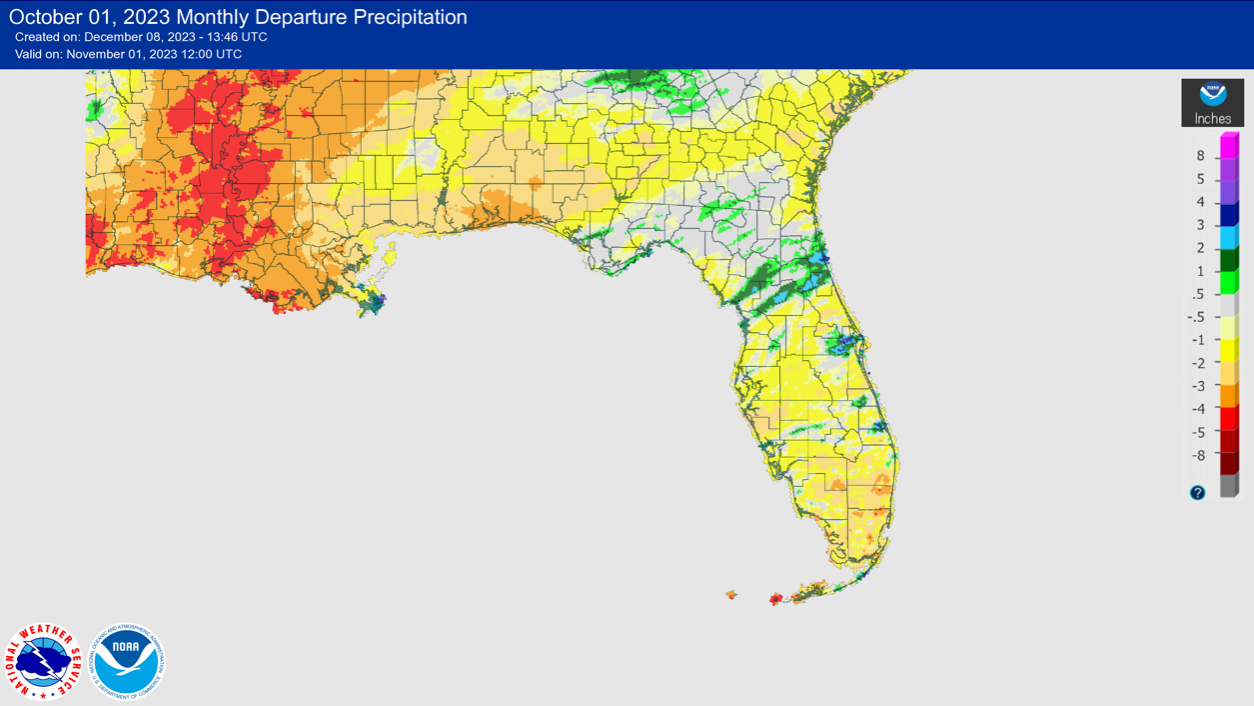
El Niño Advisory.
El Niño conditions, the warm phase of the El Niño Southern Oscillation climate pattern in the tropical equatorial Pacific Ocean, continued in October. El Niño is expected to persist through the Northern Hemisphere winter 2023-24, with an 80% chance of continuing in spring (March-May 2024). Chances of a strong El Niño event have increased to a 75-85% chance. El Niño events favor wetter and cooler than normal winters in Florida. However, El Niño rainfall is late this year with drying conditions observed in recent weeks across much of the state.
Hazardous Weather Events in October.
According to the Local Storm Reports issued by the local National Weather Service offices serving Florida, there were 138 individual local reports of hazardous weather events recorded across the state during the month of October (see Table 4 for a breakdown by event type). At the beginning of the month, heavy rainfall led to flooding of roadways in Brevard County, and high tide flooding was reported in Duval, Broward, and Nassau Counties on the 1st. An EF2 tornado was reported in Flagler County on the 12th, which caused substantial damage to several houses but no injuries or fatalities were reported.
Table 3. Breakdown of storm reports submitted in Florida during the month of October (compiled from Iowa State University/Iowa Environmental Mesonet).
| Report Type | Number of Reports |
| Heavy Rain | 36 |
| Flood | 6 |
| Flash Flood | 0 |
| Coastal Flood | 7 |
| Hail | 0 |
| Non-Thunderstorm Wind Gust | 25 |
| Non-Thunderstorm Wind Damage | 0 |
| Tornado/Waterspout/Funnel Cloud | 7/12/6 |
| Thunderstorm Wind Damage | 12 |
| Thunderstorm Wind Gust | 26 |
| Dense Fog | 1 |
Daily Record Events in October.
Table 4. Summary of daily records broken or set in Florida in October (source: NCEI Daily Weather Records).
| Category | Number of Records |
| Highest daily max. temp. | 13 |
| Highest daily min. temp. | 51 |
| Lowest daily max. temp. | 31 |
| Lowest daily min. temp. | 11 |
| Highest daily precipitation | 23 |
| Total | 129 |
Weather/Climate Highlight of the Month: Drought Development.
Drought conditions worsened across the western Panhandle, where flash drought is currently underway. Most places across north Florida have gone over 20 consecutive days without rainfall as of early November. Pasture conditions are poor with very little pasture to graze. Most cattle operations are relying on supplemental feeding. Other agriculture reports in the area indicate they are waiting on rainfall for planting.
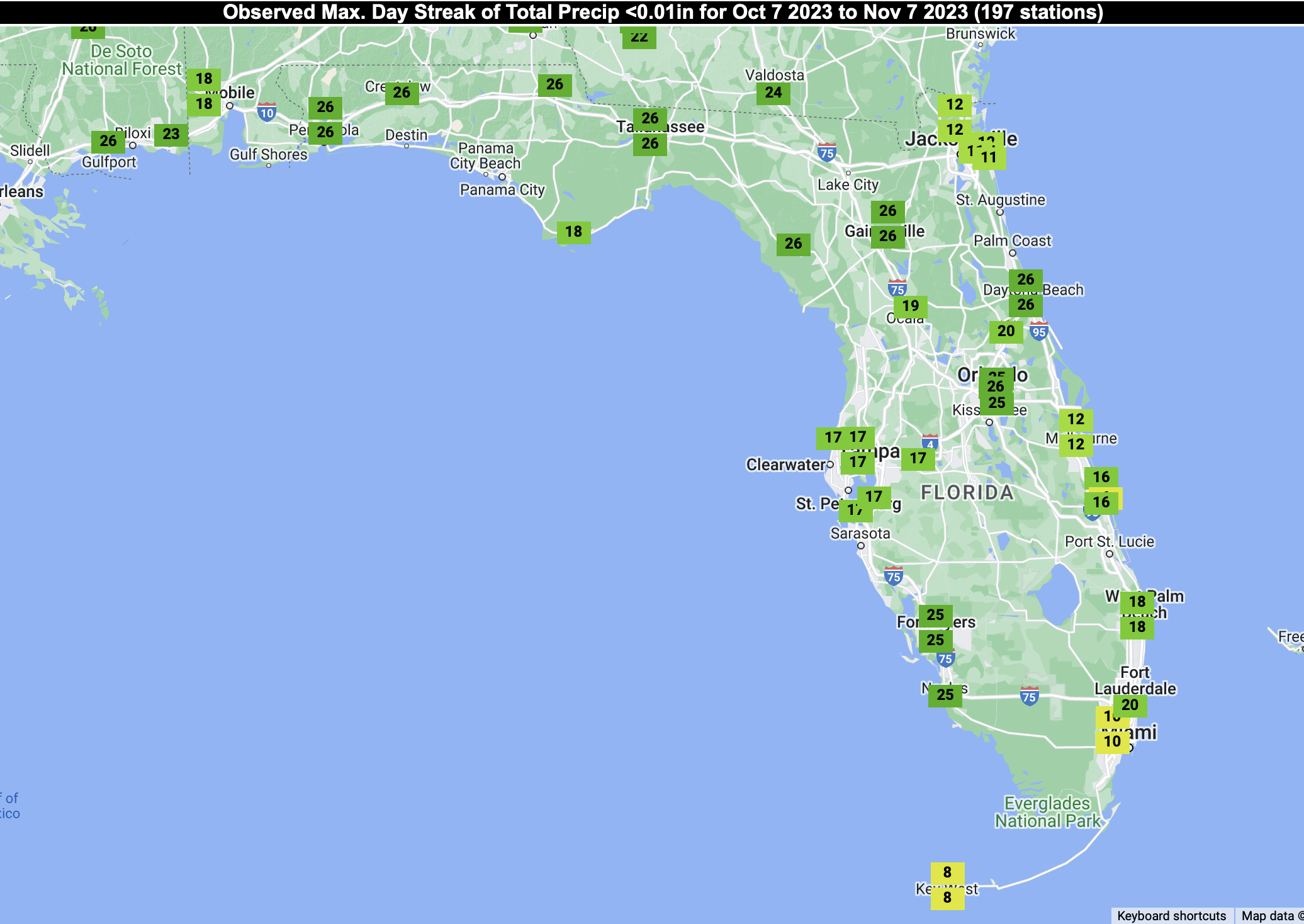
Drought-Related Impacts.
Drought persisted and deteriorated in the Panhandle and west-central coastal parts of the state in October. At the beginning of the month, drought affected the western Panhandle and west-central coast, while abnormally dry conditions were spread across North Florida. By the 17th, roughly 1% of the state was in extreme drought (D3), 9% was in severe drought (D2), 5% was experiencing moderate drought (D1), and 10% was abnormally dry (D0), according to the U.S. Drought Monitor. By the end of the month, drought degraded rapidly in the western Panhandle. By the 31st, about 8% of the state was in extreme drought (D3), 4% was in severe drought (D2), 5% was in moderate drought (D1), and 16% was abnormally dry (D0) (see Figure 2 below).
As of October 31, the Lake Okeechobee water level was 16.20 ft. above sea level (Feet-NGVD29), which is above average for this time of year. At the first of the month, the water level was 15.82 ft. above sea level.
Figure 2. A graphical depiction of the latest drought conditions in Florida according to the U.S. Drought Monitor (courtesy of the National Drought Mitigation Center, University of Nebraska-Lincoln).
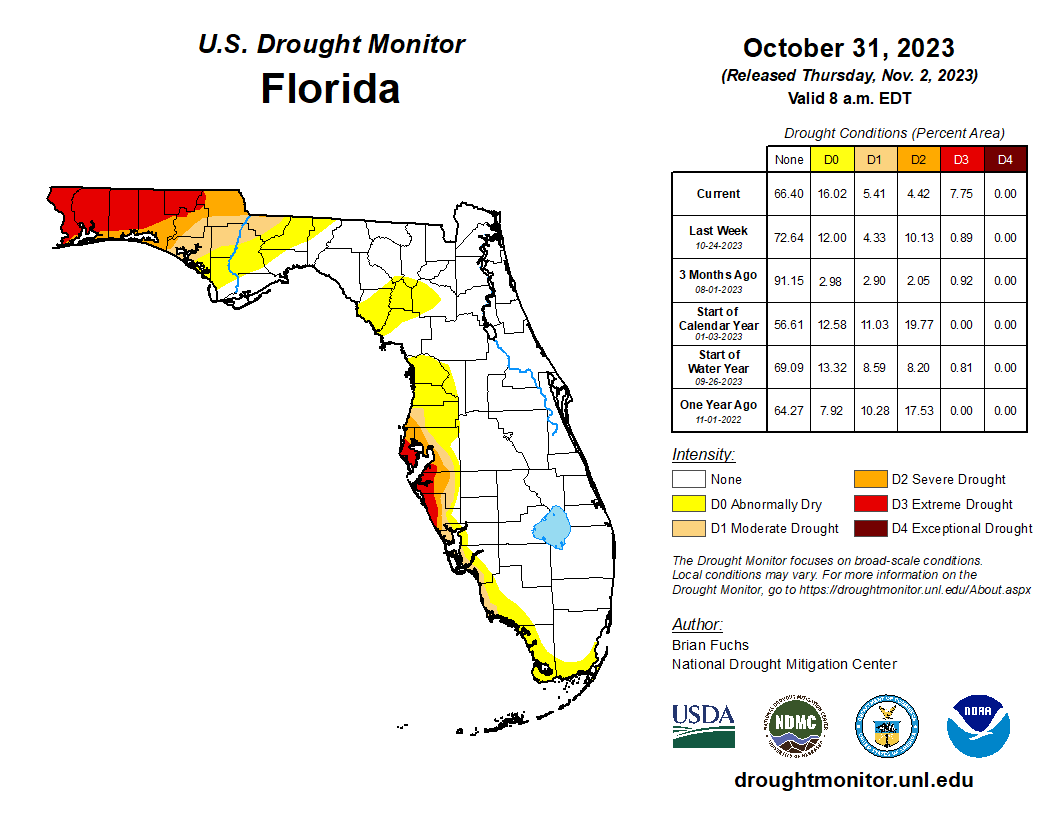
Agriculture-Related Impacts.
In mid-October, topsoil moisture conditions were adequate in 72% of the state, short in 16%, and very short in 3% of the state, while 9% of the state was experiencing surplus topsoil moisture conditions. By October 29, topsoil moisture conditions were adequate in 60% of the state, short in 23%, and very short in 16% of the state; 1% of the state was in surplus. For more information, consult the Crop Progress and Conditions Report, which is published by the USDA’s National Agricultural Statistics Service.
Appendix 1
Additional October departures from normal data for select Florida locations (Source: NWS).
| Station | Average Temperature (˚F) | Departure from Normal (˚F) | Total Rainfall (in.) | Departure from Normal (in.) |
| Gainesville | 71.5 | +0.1 | 3.73 | +1.05 |
| Sarasota | 77.8 | +0.5 | 0.70 | -2.06 |
| Naples | 79.4 | +0.9 | 2.50 | -1.43 |
| Fort Myers | 78.5 | +0.5 | 1.90 | -1.18 |
| West Palm Beach | 79.6 | +0.9 | 4.56 | -1.34 |
Appendix 2
Select daily record high minimum temperatures (°F) broken or tied during October (compiled from NOAA).
| Location | Date | Record | Broken/Tied | Last |
| Bradenton | 1 | 77 | Broken | 76 in 2019 |
| Hastings | 1 | 75 | Broken | 74 in 2017 |
| Stuart | 5 | 80 | Tied | 80 in 2018 |
| Key West | 11 | 81 | Tied | 81 in 2022 |
| Tarpon Springs | 12 | 79 | Broken | 77 in 1994 |
| Miles City | 12 | 80 | Broken | 76 in 2018 |
| Ochopee | 12 | 82 | Broken | 78 in 1995 |
| Orlando | 12 | 77 | Broken | 75 in 2005 |
| Fort Myers | 12 | 80 | Broken | 77 in 1934 |
| Key West | 12 | 85 | Broken | 82 in 2002 |
| Miami | 12 | 84 | Broken | 82 in 2009 |
| Tampa | 12 | 81 | Broken | 77 in 2009 |
| Vero Beach | 12 | 79 | Broken | 76 in 2018 |
| Lakeland | 12 | 78 | Broken | 75 in 2018 |
| Bradenton | 13 | 79 | Broken | 76 in 2005 |
| Clermont | 13 | 78 | Broken | 77 in 1994 |
| Fort Lauderdale | 13 | 82 | Broken | 78 in 2019 |
| Fort Pierce | 13 | 79 | Broken | 78 in 2008 |
| Hialeah | 13 | 81 | Broken | 80 in 2022 |
| Homestead | 13 | 80 | Broken | 75 in 2019 |
| Kissimmee | 13 | 78 | Broken | 76 in 1995 |
| Melbourne | 13 | 79 | Broken | 77 in 1954 |
| Plant City | 13 | 79 | Broken | 74 in 1912 |
| Stuart | 13 | 80 | Broken | 78 in 1986 |
| Titusville | 13 | 79 | Broken | 78 in 1999 |
| Ochopee | 13 | 80 | Broken | 76 in 2017 |
| Fort Myers | 13 | 80 | Broken | 77 in 2005 |
| Miami | 13 | 83 | Broken | 80 in 2009 |
| Key West | 13 | 84 | Broken | 82 in 2009 |
| Lakeland | 13 | 78 | Broken | 74 in 2017 |
| Fort Lauderdale | 14 | 81 | Broken | 78 in 2001 |
| Hialeah | 14 | 80 | Broken | 79 in 2009 |
| Homestead | 14 | 79 | Broken | 76 in 2014 |
| Miami | 14 | 80 | Tied | 80 in 2009 |
| Fort Lauderdale | 15 | 79 | Broken | 78 in 1983 |
| Usher Tower | 24 | 79 | Broken | 72 in 1959 |
Prepared by Florida Climate Center
The Florida State University
Tallahassee, FL
January Key Points:
- Average temperatures in January were near normal for much of the state, although temperatures varied throughout the month from record warm to record cold.
- Rainfall was generally below normal for the month, although a few places had above normal rainfall including southeastern Florida and parts of the central Panhandle.
- The La Niña advisory remains in effect and is expected to continue through spring (~67% chance).
- Moderate drought (D1) emerged in the extreme western Panhandle in January.
Average temperatures in January were near or below normal for much of Florida. Average temperature departures from normal ranged from -2.0 ̊F in Pensacola to +0.6 ̊F in Tampa for the month (see Table 1 and Appendix 1 for select cities). Temperatures varied throughout the course of the month. January began with unseasonably warm weather, when average temperature departures from normal ranged from +5 ̊F in the south to +27 ̊F in parts of northwestern Florida on the 1st of the month. From January 1-2, many stations in North and Northwest Florida observed record warm maximum and minimum temperatures. Several cold fronts then impacted the state later in the month, with record cold temperatures and freezes on the 29th and 30th impacting even southern Florida. Several stations had a record cold day on the 29th and/or 30th based on mean temperatures, including Tallahassee, Jacksonville, Gainesville, Usher, Lakeland, and Fort Lauderdale. Several daily temperature records were set throughout the month, including daily high maximum and high minimum temperatures as well as daily low maximum and low minimum temperatures (see appendices 2-5).
Table 1. January average temperatures and departures from normal ( ̊F) for selected cities.
| Station | Mean Temperature | Departure from Normal |
| Pensacola | 51.2 | -2.0 |
| Tallahassee | 51.1 | -1.1 |
| Jacksonville | 52.4 | -1.8 |
| Orlando | 61.0 | +0.4 |
| Tampa | 62.6 | +0.6 |
| Miami | 68.7 | +0.1 |
| Key West | 70.6 | 0.0 |
Rainfall totals in January were below average for much of the state. The monthly precipitation departures from normal ranged from -2.90 inches in Pensacola to +4.15 inches in Miami (Table 2 and Appendix 1). Most places across the state recorded a precipitation deficit for the month, except for parts of the central Panhandle region and southeastern Florida (Figure 1). The Cape Florida station at Key Biscayne recorded its wettest January on record, with 7.58 inches total, and Fort Lauderdale Beach had its second wettest January on record with 6.49 inches of rainfall for the month.
Table 2. January precipitation totals and departures from normal (inches) for selected cities.
| Station | Total Rainfall | Departure from Normal |
| Pensacola | 2.13 | -2.90 |
| Tallahassee | 4.34 | -0.07 |
| Jacksonville | 1.18 | -2.10 |
| Orlando | 0.92 | -1.56 |
| Tampa | 1.46 | -1.19 |
| Miami | 5.98 | +4.15 |
| Key West | 1.64 | -0.19 |
Figure 1. A graphical depiction of the monthly rainfall departure from normal (inches) for January (courtesy of NOAA, NWS).

La Niña Advisory Continues.
La Niña conditions, the cool phase of the ENSO climate pattern, continued in the tropical Pacific Ocean in January. According to the latest official NWS update, La Niña is likely to continue into the Northern Hemisphere spring (67% change during March-May) and then possibly transition to ENSO-neutral late spring/early summer (51% chance during April-June 2022).
Hazardous Weather Events in January.
According to the Local Storm Reports issued by the local National Weather Service offices serving Florida, there were 345 individual local reports of hazardous weather events recorded across the state during the month of January 2022 (see Table 4 for a breakdown by event type). Several reports of coastal flooding were reported in Taylor and Dixie Counties on the 3rd. On the 10th, 2-inch sized hail was reported in St. Lucie west of Fort Pierce. Several tornadoes associated with heavy thunderstorms moved through southwest Florida on the 16th, with 6 tornadoes reported in Collier, Lee and Charlotte Counties, including an EF2 tornado in Fort Myers. The tornadoes resulted in three injuries and localized damage.
Table 4. Breakdown of storm reports submitted in Florida during the month of January (compiled from Iowa State University/Iowa Environmental Mesonet).
| Report Type | Number of Reports |
| Flash Flood | 3 |
| Coastal Flood | 9 |
| Heavy Rain | 3 |
| Dense Fog | 0 |
| Hail | 7 |
| Marine Thunderstorm Wind | 55 |
| Non-Thunderstorm Wind Gust | 187 |
| Non-Thunderstorm Wind Damage | 4 |
| Tornado/Waterspout/Funnel Cloud | 13/3/0 |
| Thunderstorm Wind Damage | 20 |
| Thunderstorm Wind Gust | 41 |
| Lightning | 0 |
Drought-Related Impacts.
2022 began with abnormally dry conditions (D0) across much of the Panhandle. By mid-month, moderate drought conditions (D1) emerged in the extreme western Panhandle, according to the U.S. Drought Monitor. By the end of the month, abnormally dry conditions were alleviated in some parts of the Panhandle; however, moderate drought persisted but remained confined to the western Panhandle (1.36% area) and abnormally dry conditions remained across parts of the eastern Panhandle and Big Bend regions (15.93% area) (Figure 2).
As of January 31, the Lake Okeechobee water level was 14.94 ft. above sea level (Feet-NGVD29), which is above the average for this time of the year. The water level remained above average throughout the month. At the first of the month, the water level was around 15.50 ft. above sea level.
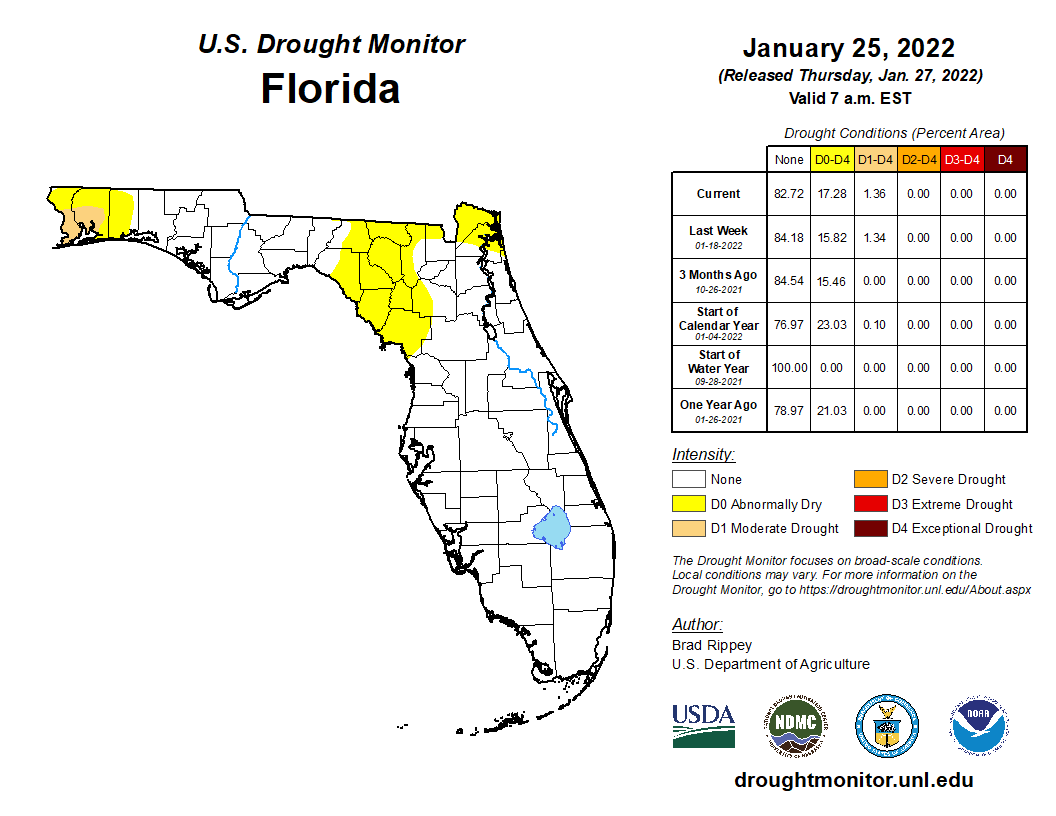
Agriculture-Related Impacts.
During the month of January, Florida cattle and pasture conditions continued to be mostly fair to good. Dry conditions and several frost events were reported during the month, which caused some damage to cover crops, fruits and vegetables. Sugarcane planting and harvest progressed well. Several citrus fruits were harvested, and several vegetable crops were marketed. For more information, consult the Crop Progress - State Stories reports, which are produced monthly December through March.
Appendix 1
Additional January departures from normal data for select Florida locations (Source: NWS).
| Station | Average Temperature (˚F) | Departure from Normal (˚F) | Total Rainfall (in.) | Departure from Normal (in.) |
| Gainesville | 54.0 | -0.8 | 0.88 | -2.41 |
| Sarasota | 62.0 | -0.4 | 0.44 | -2.35 |
| Melbourne | 61.4 | -1.9 | 1.44 | -1.19 |
| Fort Myers | 65.7 | +1.0 | 2.05 | -0.38 |
| West Palm Beach | 66.3 | 0.0 | 2.27 | -1.20 |
Appendix 2
Select daily record high maximum temperatures broken or tied during January (compiled from NOAA).
| Location | Date | Record (˚F) | Broken/Tied | Last |
| Chipley | 1 | 82 | Broken | 80 in 2020 |
| Clermont | 1 | 86 | Broken | 85 in 2019 |
| Jacksonville Beach | 1 | 82 | Broken | 81 in 1975 |
| Marianna | 1 | 84 | Broken | 80 in 2019 |
| Vero Beach | 1 | 85 | Broken | 84 in 1989 |
| Key West | 1 | 86 | Broken | 85 in 2016 |
| Orlando | 1 | 85 | Tied | 85 in 2021 |
| Crestview | 1 | 82 | Broken | 78 in 2019 |
| Jacksonville Beach | 2 | 85 | Broken | 80 in 2006 |
| Titusville | 2 | 84 | Tied | 84 in 2016 |
| Marianna | 2 | 83 | Broken | 80 in 2017 |
| Key West | 2 | 86 | Broken | 84 in 2020 |
| Jacksonville | 2 | 84 | Broken | 82 in 2017 |
| Pensacola | 2 | 78 | Broken | 77 in 2006 |
| Tallahassee | 2 | 83 | Broken | 80 in 1996 |
| Cross City | 3 | 81 | Tied | 81 in 1974 |
| Niceville | 3 | 76 | Broken | 75 in 1965 |
| Quincy | 3 | 83 | Broken | 79 in 1996 |
| Wewahitchka | 3 | 80 | Broken | 78 in 1966 |
| Key West | 7 | 85 | Broken | 84 in 2007 |
| Pensacola | 9 | 76 | Broken | 75 in 1972 |
| Clermont | 10 | 84 | Broken | 83 in 2013 |
| Punta Gorda | 10 | 86 | Broken | 84 in 2013 |
| Fort Myers | 10 | 87 | Broken | 86 in 1975 |
| Key West | 26 | 86 | Broken | 83 in 1975 |
| Fort Lauderdale | 31 | 83 | Tied | 83 in 1957 |
Appendix 3
Select daily record high minimum temperatures broken or tied during January (compiled from NOAA).
| Location | Date | Record (˚F) | Broken/Tied | Last |
| Chipley | 1 | 69 | Broken | 65 in 2019 |
| Jacksonville Beach | 1 | 73 | Broken | 68 in 2021 |
| Niceville | 1 | 69 | Broken | 63 in 2019 |
| Marianna | 1 | 71 | Broken | 67 in 2019 |
| Key West | 1 | 77 | Tied | 77 in 2016 |
| Crestview | 1 | 74 | Broken | 68 in 2019 |
| Pensacola | 1 | 73 | Broken | 68 in 2019 |
| Chipley | 2 | 72 | Broken | 65 in 2019 |
| Jacksonville Beach | 2 | 70 | Broken | 68 in 2021 |
| Niceville | 2 | 70 | Broken | 66 in 2019 |
| Panama City | 2 | 72 | Broken | 68 in 2006 |
| Perry | 2 | 72 | Broken | 69 in 2021 |
| Venice | 2 | 72 | Broken | 68 in 2021 |
| Gainesville | 2 | 68 | Broken | 65 in 2006 |
| Fort Myers | 2 | 70 | Broken | 68 in 2021 |
| Key West | 2 | 77 | Broken | 76 in 2017 |
| Tampa | 2 | 71 | Broken | 69 in 2021 |
| Tallahassee | 2 | 67 | Tied | 67 in 2006 |
| Jacksonville | 2 | 63 | Tied | 63 in 2021 |
| West Palm Beach | 8 | 73 | Tied | 73 in 1993 |
| Daytona Beach | 9 | 68 | Broken | 65 in 2013 |
| Fort Lauderdale | 9 | 75 | Broken | 73 in 2013 |
| Hialeah | 9 | 72 | Broken | 71 in 1964 |
| Jacksonville Beach | 9 | 67 | Broken | 63 in 1993 |
| Vero Beach | 9 | 72 | Broken | 67 in 2013 |
| Key West | 9 | 77 | Broken | 76 in 2013 |
| Ochopee | 26 | 65 | Broken | 62 in 2012 |
| Key West | 26 | 77 | Broken | 74 in 1957 |
Appendix 4
Select daily record low maximum temperatures broken or tied during January (compiled from NOAA).
| Location | Date | Record (˚F) | Broken/Tied | Last |
| Marianna | 21 | 45 | Broken | 46 in 2020 |
| Crestview | 21 | 40 | Broken | 44 in 1978 |
| Niceville | 22 | 38 | Broken | 42 in 1961 |
| Marianna | 22 | 44 | Broken | 48 in 2014 |
| Jacksonville | 22 | 44 | Broken | 48 in 1961 |
| Lisbon | 23 | 46 | Broken | 48 in 1985 |
| Mayo | 23 | 42 | Broken | 46 in 1987 |
| Panama City | 23 | 45 | Broken | 48 in 1987 |
| Usher Tower | 23 | 46 | Broken | 54 in 2011 |
| Deland | 29 | 47 | Broken | 53 in 1973 |
| Melbourne | 30 | 52 | Broken | 54 in 2007 |
| Usher Tower | 30 | 47 | Tied | 47 in 2014 |
| Perrine | 31 | 62 | Broken | 69 in 2014 |
Appendix 5
Select daily record low minimum temperatures broken or tied during January (compiled from NOAA).
| Location | Date | Record (˚F) | Broken/Tied | Last |
| Wewahitchka | 23 | 22 | Broken | 24 in 2011 |
| Deland | 29 | 16 | Broken | 20 in 1940 |
| Ochopee | 29 | 39 | Broken | 40 in 2011 |
| Archbold Bio Station | 30 | 21 | Broken | 23 in 2007 |
| Perrine | 30 | 38 | Broken | 43 in 2017 |
| Plant City | 30 | 27 | Broken | 28 in 1900 |
| Wauchula | 30 | 25 | Broken | 28 in 1978 |
| Miles City | 30 | 34 | Broken | 39 in 2007 |
| Marianna | 30 | 22 | Broken | 24 in 2014 |
| Fort Myers | 30 | 35 | Tied | 35 in 1978 |
| Vero Beach | 30 | 30 | Broken | 35 in 1955 |
| Archbold Bio Station | 31 | 20 | Broken | 30 in 2017 |
| Perrine | 31 | 37 | Broken | 44 in 2009 |
| Tampa Bay | 31 | 35 | Tied | 35 in 1977 |
| Wauchula | 31 | 25 | Broken | 26 in 1966 |
| Miles City | 31 | 35 | Broken | 40 in 2009 |
| Vero Beach | 31 | 28 | Broken | 34 in 2017 |
Prepared by Florida Climate Center
The Florida State University
Tallahassee, FL
Key Points:
- Monthly average temperatures in April were near to above normal across the state; several locations in central and south Florida observed one of their top five warmest Aprils on record.
- Moderate (D1) to severe (D2) drought conditions are impacting much of the southern Peninsula as of the end of April; however, drought removal is forecasted for most of this region by the end of May.
- La Niña conditions are favored to continue through fall, with a 59% chance of La Niña continuing through summer (June-August) and a 50-55% chance through fall.
Average temperatures in April were near to above normal across the state Average temperature departures from normal ranged from +0.1 ̊F in Jacksonville to +3.0 ̊F in Tampa for the month (see Table 1 and Appendix 1 for select cities). Many places in central and southern Florida recorded one of their top 5 warmest Aprils on record, including Tampa (3rd-warmest), Homestead (3rd-warmest), Perrine (4th-warmest), Orlando (5th-warmest), and Miami (5th-warmest). Several daily high maximum and high minimum temperature records were tied or broken throughout the month (see appendices 2 and 3).
Table 1. April average temperatures and departures from normal ( ̊F) for selected cities.
| Station | Mean Temperature | Departure from Normal |
| Pensacola | 70.5 | +2.2 |
| Tallahassee | 68.0 | +0.7 |
| Jacksonville | 68.2 | +0.1 |
| Orlando | 74.6 | +2.4 |
| Tampa | 76.9 | +3.0 |
| Miami | 78.6 | +1.9 |
| Key West | 78.4 | +0.5 |
Rainfall totals in April were mixed, with the Panhandle and Big Bend regions receiving below normal precipitation and much of eastern and central Florida above normal. The monthly precipitation departures from normal ranged from -1.49 inches in Pensacola to +4.21 inches in Tampa (Table 2 and Appendix 1). Year-to-date rainfall deficits exist for many locations, including Pensacola with 5.54 inches below normal to date, Venice with 5 inches of deficit to date, and Vero Beach at 4.4 inches in deficit to date. Due to persistent dry conditions, moderate to severe drought continues to impact much of the southern Peninsula as of the end of April (see below).
Table 2. April precipitation totals and departures from normal (inches) for selected cities.
| Station | Total Rainfall | Departure from Normal |
| Pensacola | 4.03 | -1.49 |
| Tallahassee | 2.43 | -1.10 |
| Jacksonville | 5.22 | +2.29 |
| Orlando | 5.20 | +2.62 |
| Tampa | 6.76 | +4.21 |
| Miami | 4.66 | +1.30 |
| Key West | 2.54 | +0.47 |
Figure 1. A graphical depiction of the monthly rainfall departure from normal (inches) for April (courtesy of NOAA, NWS).
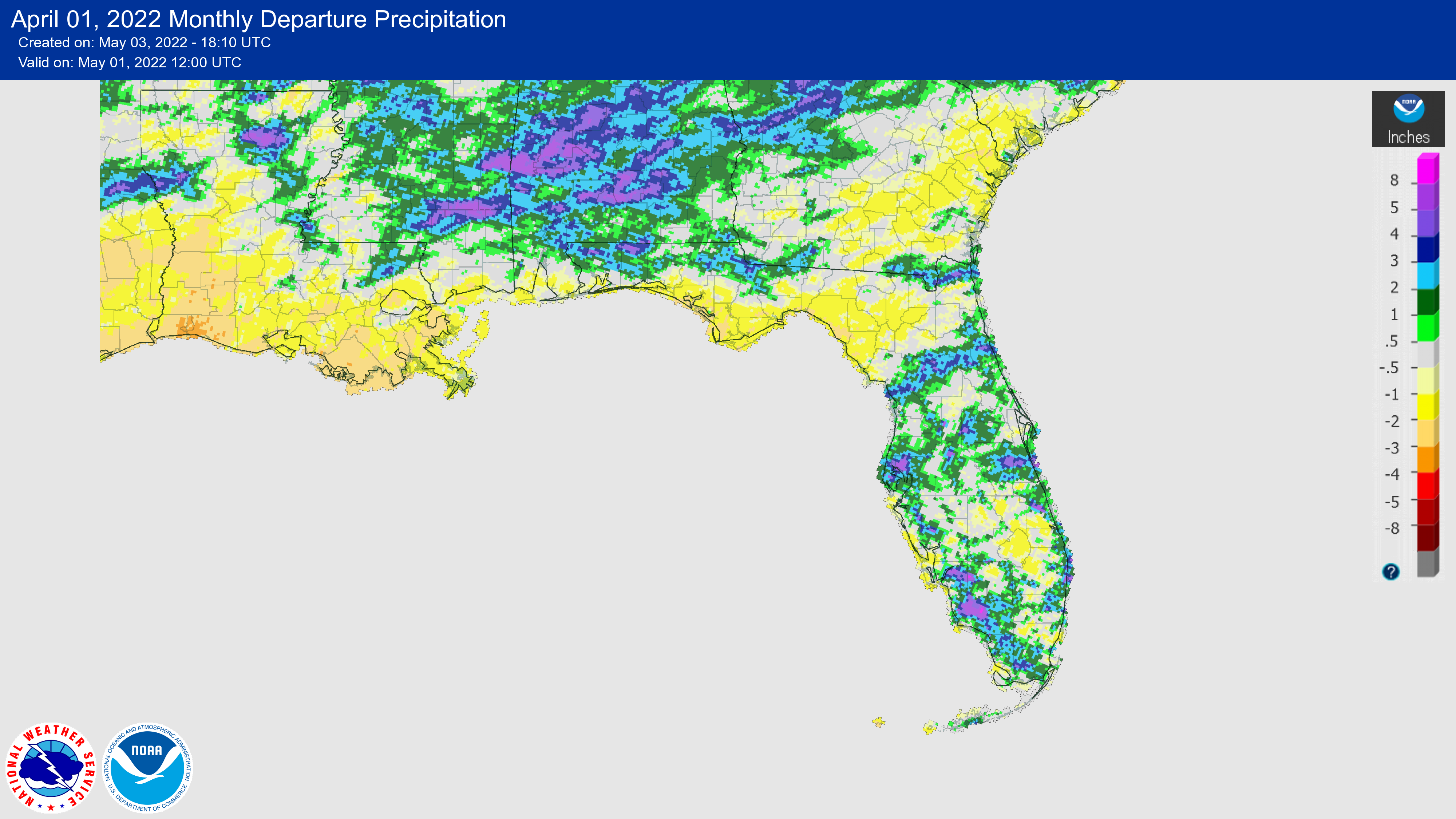
La Niña Advisory.
La Niña, the cool phase of the ENSO climate pattern, is favored to continue through the Northern Hemisphere summer (59% chance during June-August), with a 50-55% chance of La Niña continuing through the fall. In early April, all of the Niño index regions were between -0.7°C and -1.1°C. Additionally, the coupled ocean-atmosphere system reflects the continuation of La Niña, though there is still much uncertainty given the combined 45-50% chance for ENSO-neutral or El Niño in the July-September period onwards.
Hazardous Weather Events in April.
According to the Local Storm Reports issued by the local National Weather Service offices serving Florida, there were 392 individual local reports of hazardous weather events recorded across the state during the month of April (see Table 4 for a breakdown by event type). April saw a lot of thunderstorm activity with strong wind gusts (up to 78 mph in Palm Beach on the 6th), and hail up to 2 inches in diameter (reported in St. Johns County on the 17th). Several Mesonet and CoCoRaHS stations recorded over 5 inches and as much as 6.83 inches of rain on the 7th in Nassau County. There were two fatalities due to rip currents during the month, one in Daytona Beach and one in Mayport.
Table 4. Breakdown of storm reports submitted in Florida during the month of April (compiled from Iowa State University/Iowa Environmental Mesonet).
| Report Type | Number of Reports |
| Flash Flood | 1 |
| Heavy Rain | 20 |
| Flood | 9 |
| Hail | 76 |
| Lightning | 4 |
| Marine Thunderstorm Wind | 39 |
| Non-Thunderstorm Wind Gust | 77 |
| Non-Thunderstorm Wind Damage | 3 |
| Tornado/Waterspout/Funnel Cloud | 5/6/10 |
| Thunderstorm Wind Damage | 41 |
| Thunderstorm Wind Gust | 95 |
| Wildfire | 4 |
Drought-Related Impacts.
At the beginning of April, nearly 1% of the state was in severe drought (D2), about 21% was in moderate drought (D1), and another 21% was abnormally dry (D0), according to the U.S. Drought Monitor. As of April 26th, 5% of the state was in severe drought (D2), 19% was in moderate drought (D1), and 9% had abnormally dry conditions. Drought was concentrated in the southern Peninsula (Figure 2).
As of April 30, the Lake Okeechobee water level was 12.96 ft. above sea level (Feet-NGVD29), which is below average for this time of the year. The water level continued to decline throughout the month but remained well above the water shortage management threshold. At the first of the month, the water level was around 13.77 ft. above sea level.
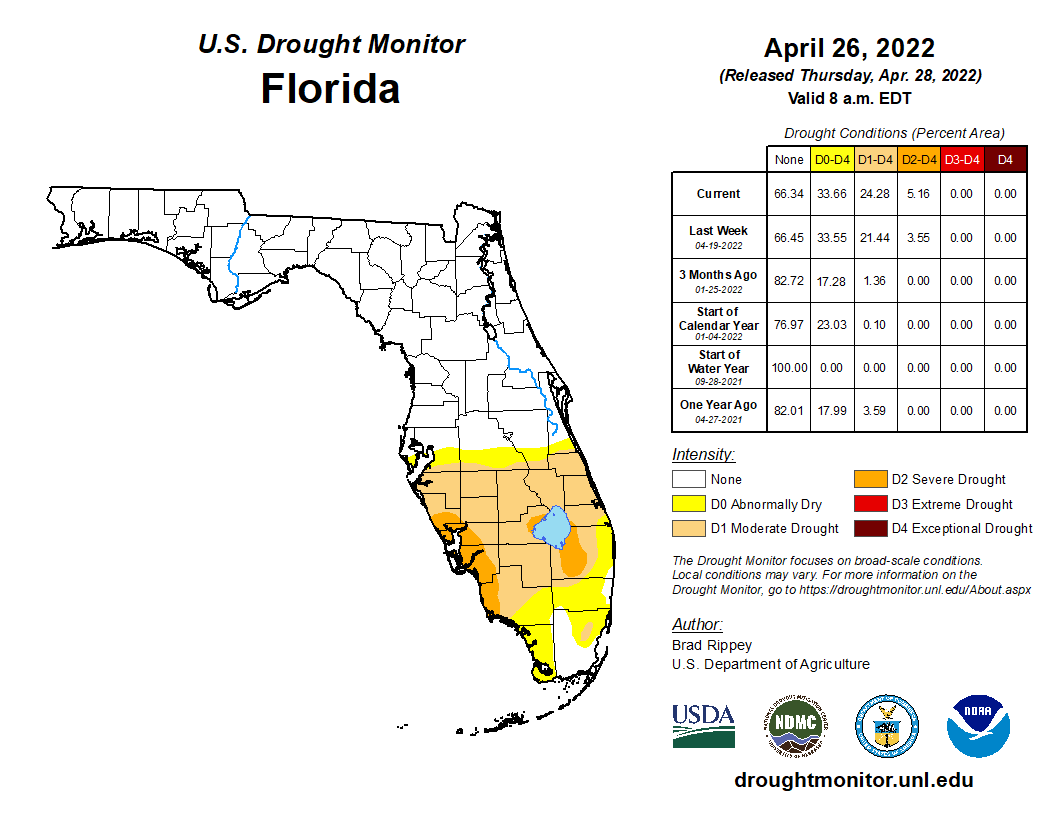
Agriculture-Related Impacts.
During mid-April, topsoil moisture conditions were adequate in 64% of the state, short in 23%, and very short in 5% of the state; 8% of the state had a surplus. By the end of April, topsoil moisture declined slightly with levels adequate in 60% of the state, short in 32%, and very short in 5% of the state, while 3% of the state was in surplus. For more information, consult the Crop Progress and Conditions report, which is published by the USDA's National Agricultural Statistics Service.
Appendix 1
Additional April departures from normal data for select Florida locations (Source: NWS).
| Station | Average Temperature (˚F) | Departure from Normal (˚F) | Total Rainfall (in.) | Departure from Normal (in.) |
| Gainesville | 69.4 | +0.9 | 1.61 | -1.13 |
| Sarasota | 74.5 | +1.9 | 1.97 | -0.49 |
| Melbourne | 73.3 | +0.2 | 5.82 | +3.53 |
| Fort Myers | 77.5 | +2.7 | 5.83 | +3.39 |
| West Palm Beach | 77.1 | +2.2 | 6.40 | +2.72 |
Appendix 2
Select daily record high maximum temperatures broken or tied during April (compiled from NOAA).
| Location | Date | Record (˚F) | Broken/Tied | Last |
| Key West | 1 | 90 | Broken | 88 in 2011 |
| Fort Myers | 4 | 90 | Tied | 90 in 2017 |
| Bradenton | 5 | 89 | Broken | 88 in 1999 |
| Pensacola | 5 | 80 | Broken | 79 in 2009 |
| Key West | 5 | 90 | Broken | 87 in 1977 |
| Orlando | 6 | 93 | Broken | 90 in 1956 |
| Vero Beach | 6 | 92 | Broken | 91 in 2012 |
| Key West | 6 | 90 | Broken | 88 in 2009 |
| Orlando | 6 | 91 | Broken | 89 in 1956 |
| Crestview | 6 | 86 | Broken | 85 in 2006 |
| Clermont | 7 | 92 | Broken | 91 in 2019 |
| Fort Lauderdale | 7 | 91 | Broken | 90 in 2009 |
| Kissimmee | 7 | 91 | Broken | 89 in 2019 |
| Perrine | 7 | 90 | Broken | 89 in 2017 |
| West Palm Beach | 7 | 90 | Tied | 90 in 2018 |
| Key West | 7 | 90 | Broken | 87 in 2020 |
| Hialeah | 8 | 92 | Broken | 90 in 1998 |
| Stuart | 8 | 91 | Tied | 91 in 2018 |
| Lakeland | 11 | 92 | Broken | 91 in 1965 |
| Key West | 14 | 90 | Broken | 89 in 2020 |
| Bradenton | 17 | 90 | Broken | 88 in 1994 |
| Canal Point | 17 | 95 | Broken | 91 in 1972 |
| Clermont | 17 | 90 | Tied | 90 in 1967 |
| Lakeland | 17 | 91 | Broken | 90 in 1995 |
| Clermont | 18 | 93 | Broken | 91 in 1968 |
| Cross City | 18 | 90 | Broken | 89 in 1970 |
| Tampa | 18 | 91 | Broken | 89 in 2013 |
| Key West | 18 | 90 | Broken | 89 in 2020 |
| Fort Myers | 19 | 93 | Tied | 93 in 1972 |
| Tampa | 24 | 90 | Tied | 90 in 2002 |
| Key West | 30 | 89 | Broken | 88 in 2020 |
Appendix 3
Select daily record high minimum temperatures broken or tied during April (compiled from NOAA).
| Location | Date | Record (˚F) | Broken/Tied | Last |
| Bartow | 1 | 71 | Broken | 70 in 1998 |
| Fort Lauderdale Beach | 1 | 77 | Broken | 75 in 2016 |
| Tampa | 1 | 71 | Broken | 70 in 1998 |
| Venice | 1 | 75 | Broken | 72 in 1973 |
| Fort Myers | 1 | 74 | Broken | 72 in 1998 |
| West Palm Beach | 1 | 76 | Tied | 76 in 2016 |
| Key West | 1 | 81 | Broken | 78 in 1975 |
| Kissimmee | 2 | 71 | Broken | 70 in 1970 |
| Key West | 2 | 82 | Broken | 78 in 2016 |
| Key West | 4 | 80 | Broken | 79 in 1973 |
| Key West | 5 | 82 | Broken | 78 in 2008 |
| Bradenton | 6 | 74 | Broken | 69 in 1982 |
| Fort Lauderdale | 6 | 76 | Broken | 75 in 2017 |
| Lisbon | 6 | 69 | Broken | 68 in 1969 |
| Perrine | 6 | 71 | Broken | 70 in 2009 |
| Tarpon Springs | 6 | 75 | Broken | 74 in 1982 |
| Titusville | 6 | 72 | Broken | 70 in 1958 |
| Venice | 6 | 76 | Broken | 70 in 1958 |
| Miles City | 6 | 69 | Broken | 68 in 2020 |
| Ochopee | 6 | 72 | Broken | 69 in 2020 |
| Gainesville | 6 | 73 | Broken | 66 in 1999 |
| Key West | 6 | 79 | Broken | 78 in 1982 |
| Miami | 6 | 78 | Broken | 75 in 2003 |
| Orlando | 6 | 74 | Broken | 72 in 1933 |
| Tampa | 6 | 77 | Broken | 70 in 1991 |
| Key West | 6 | 82 | Broken | 77 in 2020 |
| Pensacola | 6 | 74 | Broken | 70 in 1954 |
| Cross City | 7 | 74 | Broken | 67 in 1964 |
| Fort Lauderdale | 7 | 77 | Broken | 74 in 2003 |
| Glen St. Mary | 7 | 70 | Broken | 65 in 1999 |
| Jacksonville Beach | 7 | 74 | Broken | 71 in 1956 |
| Lake City | 7 | 70 | Broken | 67 in 1956 |
| Lisbon | 7 | 72 | Broken | 70 in 1964 |
| Melbourne | 7 | 73 | Broken | 71 in 1954 |
| Perry | 7 | 75 | Broken | 68 in 2003 |
| Sanford | 7 | 76 | Broken | 70 in 1997 |
| Usher Tower | 7 | 74 | Broken | 69 in 2003 |
| Miami | 7 | 78 | Broken | 76 in 2020 |
| Key West | 7 | 81 | Broken | 78 in 1973 |
| Key West | 16 | 80 | Broken | 79 in 2020 |
| Jacksonville Beach | 17 | 73 | Broken | 70 in 1982 |
| Usher Tower | 17 | 67 | Broken | 66 in 2015 |
| Jacksonville Beach | 18 | 76 | Broken | 70 in 2020 |
| Daytona Beach | 18 | 71 | Broken | 70 in 2020 |
| Key West | 18 | 80 | Broken | 79 in 2020 |
| Fort Lauderdale | 22 | 75 | Broken | 74 in 2018 |
| Naples | 28 | 76 | Broken | 73 in 1960 |
| Naples | 29 | 75 | Broken | 73 in 2017 |
| Key West | 29 | 80 | Broken | 79 in 1991 |

